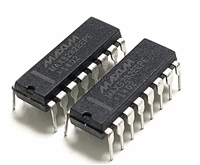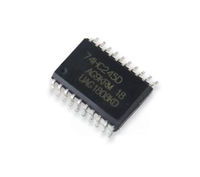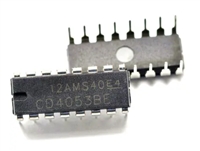AD2S80A
CONVERTER OPERATION
POSITION OUTPUT
When connected in a circuit such as shown in Figure 1 the
AD2S80A operates as a tracking resolver-to-digital converter
and forms a Type 2 closed-loop system. The output will auto-
matically follow the input for speeds up to the selected maximum
tracking rate. No convert command is necessary as the conversion
is automatically initiated by each LSB increment, or decre-
ment, of the input. Each LSB change of the converter initiates a
BUSY pulse.
The resolver shaft position is represented at the converter output
by a natural binary parallel digital word. As the digital position
output of the converter passes through the major carries, i.e., all
“1s” to all “0s” or the converse, a RIPPLE CLOCK (RC) logic
output is initiated indicating that a revolution or a pitch of the
input has been completed.
The direction of input rotation is indicated by the DIRECTION
(DIR) logic output. This direction data is always valid in advance
of a RIPPLE CLOCK pulse and, as it is internally latched, only
changing state (1 LSB min change) with a corresponding
change in direction.
The AD2S80A is remarkably tolerant of input amplitude and
frequency variation because the conversion depends only on the
ratio of the input signals. Consequently there is no need for
accurate, stable oscillator to produce the reference signal. The
inclusion of the phase sensitive detector in the conversion loop
ensures a high immunity to signals that are not coherent or are
in quadrature with the reference signal.
Both the RIPPLE CLOCK pulse and the DIRECTION data
are unaffected by the application of the INHIBIT. The static
positional accuracy quoted is the worst case error that can occur
over the full operating temperature excluding the effects of
offset signals at the INTEGRATOR INPUT (which can be
trimmed out—see Figure 1), and with the following conditions:
input signal amplitudes are within 10% of the nominal; phase
shift between signal and reference is less than 10 degrees.
SIGNAL CONDITIONING
The amplitude of the SINE and COSINE signal inputs should
be maintained within 10% of the nominal values if full perfor-
mance is required from the velocity signal.
These operating conditions are selected primarily to establish a
repeatable acceptance test procedure which can be traced to
national standards. In practice, the AD2S80A can be used well
outside these operating conditions providing the above points
are observed.
The digital position output is relatively insensitive to amplitude
variation. Increasing the input signal levels by more than 10%
will result in a loss in accuracy due to internal overload. Reduc-
ing levels will result in a steady decline in accuracy. With the
signal levels at 50% of the correct value, the angular error will
increase to an amount equivalent to 1.3 LSB. At this level the
repeatability will also degrade to 2 LSB and the dynamic response
will also change, since the dynamic characteristics are propor-
tional to the signal level.
VELOCITY SIGNAL
The tracking converter technique generates an internal signal at
the output of the integrator (the INTEGRATOR OUTPUT
pin) that is proportional to the rate of change of the input angle.
This is a dc analog output referred to as the VELOCITY signal.
The AD2S80A will not be damaged if the signal inputs are applied
to the converter without the power supplies and/or the reference.
In many applications it is possible to use the velocity signal of
the AD2S80A to replace a conventional tachogenerator.
REFERENCE INPUT
The amplitude of the reference signal applied to the converter’s
input is not critical, but care should be taken to ensure it is kept
within the recommended operating limits.
DC ERROR SIGNAL
The signal at the output of the phase sensitive detector
(DEMODULATOR OUTPUT) is the signal to be nulled by
the tracking loop and is, therefore, proportional to the error
between the input angle and the output digital angle. This is the
dc error of the converter; and as the converter is a Type 2 servo
loop, it will increase if the output fails to track the input for any
reason. It is an indication that the input has exceeded the maxi-
mum tracking rate of the converter or, due to some internal
malfunction, the converter is unable to reach a null. By connect-
ing two external comparators, this voltage can be used as a
“built-in-test.”
The AD2S80A will not be damaged if the reference is sup-
plied to the converter without the power supplies and/or the
signal inputs.
HARMONIC DISTORTION
The amount of harmonic distortion allowable on the signal and
reference lines is 10%.
Square waveforms can be used but the input levels should be
adjusted so that the average value is 1.9 V rms. (For example, a
square wave should be 1.9 V peak.) Triangular and sawtooth
waveforms should have a amplitude of 2 V rms.
Note: The figure specified of 10% harmonic distortion is for
calibration convenience only.
REV. B
–7–






 MAX3232 RS-232电平转换器资料手册参数分析
MAX3232 RS-232电平转换器资料手册参数分析

 MAX485 RS-485/RS-422收发器资料手册参数分析
MAX485 RS-485/RS-422收发器资料手册参数分析

 74HC245八路双向总线收发器:资料手册参数分析
74HC245八路双向总线收发器:资料手册参数分析

 CD4053模拟多路复用器/解复用器:资料手册参数分析
CD4053模拟多路复用器/解复用器:资料手册参数分析
